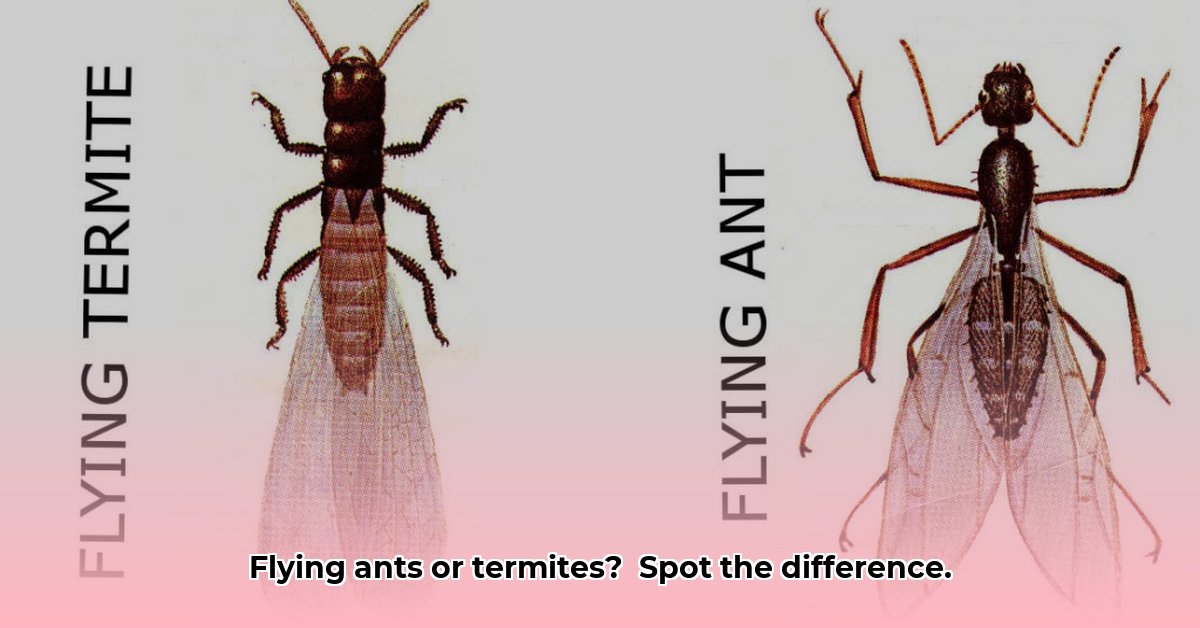Why Correct Identification Matters
Mistaking a flying ant for a termite can be a costly error. Termites can cause significant structural damage to your home, while flying ants are primarily a nuisance. Accurate identification is crucial for effective treatment and preventing costly repairs. This guide provides a clear, step-by-step identification process, combining detailed descriptions with visual comparisons to help you quickly and confidently distinguish between these two winged insects.
Spot the Difference: A Visual Guide
A side-by-side comparison highlights the key differences between flying ants and termites:
| Feature | Flying Ant | Termite |
|---|---|---|
| Antennae | Bent, elbowed (like an “L”) | Straight, beaded (like a string of pearls) |
| Waist | Narrow, pinched (like a wasp) | Broad, uniform (no constriction) |
| Wings | Two pairs, front wings longer | Two pairs, equal length |
| Body | Darker (black, brown, or red) | Lighter (pale yellow, tan, or translucent) |
[Insert high-resolution, labeled side-by-side close-up images of flying ants and termites, clearly marking antennae, waist, wings, and body shape. Example image labels: “Bent Antennae,” “Pinched Waist,” “Uneven Wings,” “Broad Waist,” “Straight Antennae,” “Equal Wings.”]
Step-by-Step Identification
- Collect a Sample: If possible, safely collect a few insects in a sealed container for closer examination.
- Antennae Check: Examine the antennae. Bent or elbowed? Probably an ant. Straight and beaded? Likely a termite.
- Waist Examination: Look at the waist area. Narrow and pinched? Suggests an ant. Broad and uniform? Points towards a termite.
- Wing Inspection: Are all four wings the same size? This suggests a termite. Are the front wings longer? This is indicative of an ant. Termite wings also detach easily.
- Body Color: Observe the body color. Darker colors are typical of ants. Lighter, more uniform colors often signal termites.
Beyond Looks: Behavioral Clues
Behavior can offer additional clues:
- Location: Swarming near damp, damaged wood? This could indicate termites. Swarming after rain, near pavement cracks, or mounds? More likely ants.
- Mud Tubes: Presence of mud tubes on walls or foundations is a strong indicator of subterranean termites.
- Discarded Wings: Piles of discarded wings near windowsills or light sources often suggest termites.
What to Do if You See Swarmers
- Don’t Panic: Remain calm and try to collect a sample.
- Contact a Professional: Call a qualified pest control professional immediately for a thorough inspection and identification.
Regional Variations and Swarming Seasons
Termite species and swarming seasons vary geographically. Research what’s common in your area. Some research suggests that climate change may be influencing these patterns, so traditional swarming seasons aren’t always reliable.
Prevention Tips
- Moisture Control: Repair leaks promptly and ensure proper drainage around your foundation.
- Wood Contact: Avoid wood-to-soil contact. Store firewood away from your home and elevate it off the ground.
- Regular Inspections: Schedule annual professional pest control inspections.
Debunking Common Myths
- Myth: All swarming ants are carpenter ants. Reality: Many ant species have a swarming stage. Carpenter ants do nest in wood, but unlike termites, they don’t eat it. They excavate galleries, leaving behind coarse sawdust-like frass.
- Myth: Termites only infest old homes. Reality: Termites can infest any home, regardless of age, if conditions are favorable.
Call to Action
If you’re unsure about the insects you’ve found, don’t take chances. Contact a pest control professional for expert identification and a personalized treatment plan. Early detection is key to minimizing potential damage. While this guide helps with initial identification, professional assessment offers definitive answers and appropriate solutions. Ongoing research continues to expand our understanding of termite behavior and control, so consulting experts ensures you’re getting the most up-to-date advice.
- NYT Connections Answer: Hedgehog, Pineapple, Cactus The Spiky Things Explained - April 20, 2025
- How to Clean a Wool Carpet: A Comprehensive Guide - April 20, 2025
- How to Clean a Pleather Couch: A Complete Guide - April 20, 2025










